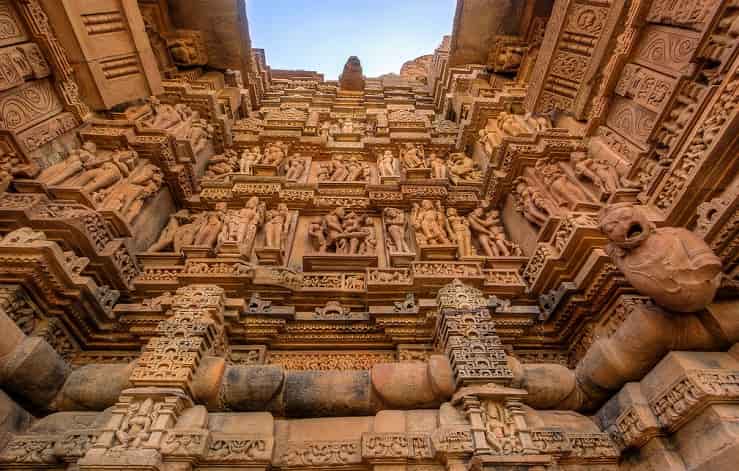Last Updated on December 23, 2024
Khajuraho group monuments are one of the seven wonders of India. They are also listed as a UNESCO World Heritage Site. The reason why they are the main attraction in Madhya Pradesh is that Khajuraho is a town with a large group of medieval Hindu and Jain temples, renowned for their erotic carved sculptures.

Khajuraho means “golden date palms,” known as khajur in Hindi. It is said that in ancient times, this town was lined with date palm trees, and therefore, it was named after them.
The erotic sculptures carved on the outer walls of the temples have attracted the attention of art lovers from all over the world, but there is still mystery surrounding the purpose of their construction.
These temples have raised many questions in the minds of people who visit. Some wonder if the sculptures depict sexual acts between deities. It is believed that these sculptures symbolize the idea that one should leave their sexual desires outside the temple before entering. Additionally, there are carvings that depict the daily lives of people from the 10th and 11th centuries AD—potters, farmers, women applying makeup, musicians, warriors, and others. They also depict changes in the human body, both physically and mentally, and offer insights into the facts of life.
These temples were constructed between 950 and 1050 AD. The main temples are dedicated to Brahma, Vishnu, and Shiva. According to Hindu mythology, these three gods are believed to be the creator, protector, and destroyer of the earth, respectively. There were originally 85 temples in Khajuraho, but now only 22 temples are in good condition. These temples are spread over about 8 square miles. Presently, these temples are categorized into the Western and Eastern groups. About 45 km away from Khajuraho is Panna, from where sandstone was transported to build these temples.
This town also witnessed the destruction of temples and disfigurement of deity faces during the invasion of Qutbuddin Aibak in 1203 AD. In 1838, British engineer T.S. Burt rediscovered the remaining temples when the jungle had begun to take a toll on them.
The architectural designs of Khajuraho temples follow the Nagara style, which is typical of northern India’s architecture. The Nagara style is beehive-shaped and multi-layered, known as Shikhara. Nagara style was developed in the 5th century AD, and advancements in its architectural design can be seen in the temples of Khajuraho. These temples demonstrate not only the artistry of the craftsmen but also the broad vision of the Chandela Rajputs, who were responsible for the creation of these temples.
According to the geographical distribution, the temples are divided into groups as they are scattered over a distance of about 20 kilometers: Western, Eastern, and Southern.
Western Group
The Western group contains the largest and most prominent temples. The Kandariya Mahadeo Temple, dedicated to Lord Shiva, is the largest. It features a large idol of Lord Shiva and a Shiva Lingam. Apart from this, there are over 900 statues and intricately carved entrance arches, pillars, and ceilings.
Another major temple in the Western group is the Chaunsat Yogini Temple, dedicated to Goddess Kali, as well as the Matangeshwar Temple, dedicated to Lord Shiva. The Western group of temples is known for their graceful carvings and minute details.
Eastern Group
The Eastern group temples include both Jain and Hindu temples. Among the three Jain temples, the most notable is the Parsvanatha Temple, dedicated to Lord Parsvanath. This temple is famous for its detailed carvings that depict daily life during that period.
Southern Group
The Southern temples are located on the outskirts of Khajuraho. Two major temples here are dedicated to Lord Shiva and Lord Vishnu.
Accommodation
In Khajuraho, there are options for both luxury and budget accommodations. Whether you’re looking for a five-star hotel or a smaller budget hotel, staying in Khajuraho is not a problem, regardless of your budget.
Transportation
Khajuraho has its own airport, located nearby, with flights connecting to various parts of India, including Delhi, Agra, and Varanasi. The town is also well connected by road to other parts of Madhya Pradesh and India.




 Call
Call Enquiry
Enquiry